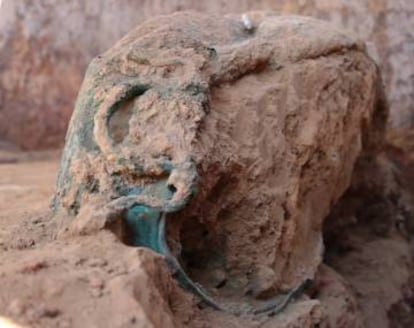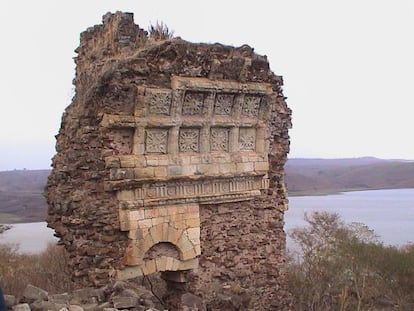The team unearthing the secrets of Spain¡¯s mysterious Tartessian culture
Archeologists dig up the biggest and best-preserved examples so far of the legendary civilization


In the middle of the hot, dusty landscape in Las Vegas del Guadiana, in Spain's southwestern Badajoz province, two archeologists from the Spanish National Research Council (CSIC) scrape patiently at the hard-baked earth with tiny trowels. They don¡¯t have to wait long for their reward.
On the Turu?uelo site where the remains of a vast 2,500-year-old building are being uncovered, all sorts of objects poke out of the soil: spearheads, pots, hooks and, excitingly, a bronze grill and large bronze cauldron.
Understanding the culture is pretty complicated due to all the missing information
Esther Rodr¨ªguez, dig co-director
The room they are currently excavating is particularly notable for the cache of bronze artifacts, according to CSIC researcher and director of the M¨¦rida Institute of Archeology, Sebasti¨¢n Celestino.
He has just dug up a metal object representing two doves separated by an outstretched bullhide, a divine symbol common to the Tartessians¨C a Bronze Age civilization that traded with the Phoenicians and who settled in the fertile southwest of the Iberian Peninsula, and whose mysterious origins and ultimate disappearance have given rise to a plethora of myths and legends over the centuries.
Now, however, science is rapidly dispelling these myths and the Turu?uelo dig, which is centered on one of the best-preserved architectural remains of the era, covering as much as a hectare of land, should go some way toward putting the remaining pieces of the puzzle in place.

¡°We are in the final phase of the Tartessian period here, in the fifth century BCE,¡± says Celestino. ¡°The main hub was located around the Guadalquivir River and the modern-day city of Huelva, but after being struck by an economic crisis in the sixth century BCE, there was migration inland. And the people who settled around the Guadiana River put up these enormous buildings.¡±
Celestino is talking about three massive constructions in particular: the Cancho Roano sanctuary in Zalamea de la Serena, on which Celestino himself worked for over 20 years; La Mata in the district of Campanario, which appeared to have a commercial purpose, and this one in Turu?uelo, whose function is yet to be revealed.
¡°All we know is that it was clearly used for worship,¡± says Celestino who, along with the dig¡¯s co-director, Esther Rodr¨ªguez, has only excavated 10% of the site.
The three buildings shared not only a distant period of history but also a violent end. It seems they were destroyed by their own inhabitants, burned and then sealed with clay. ¡°At the end of the fifth century BCE and the start of the fourth century, Celts from the north started to move down. By destroying their own buildings, they not only saved them from the invasions, but also for posterity,¡± explains Celestino.
This didn¡¯t just happen with the main building ¨C others documented in the Valle Medio del Guadiana also appear to have received similar treatment, according to Rodr¨ªguez. ¡°The fact they were abandoned at the same time indicates that they were part of the same political system,¡± she says.
¡°It appears that life in this period was organized around centers such as Cancho Roano or Turu?uelo and radiated out. There was an even bigger site, el Tamborrio in Villanueva de la Serena, which had more political power. But the relationship between these bases is still difficult to establish.¡±
By destroying their own buildings, they not only saved them from the invasions, but also for posterity
Sebasti¨¢n Celestino, dig co-director
While these self-destructive measures offer clues to the Tartessian political structure, the clay sealing has given scientists an incredible insight into the Tartessian way of life. ¡°Understanding the culture is pretty complicated due to all the missing information,¡± says Rodr¨ªguez. ¡°But it is true that the level of preservation of the remains from Valle Medio del Guadiana allows us to at least document it.¡±
Consequently, archeological digs like this provide a better picture of Tartessian culture around the Guadalquivir from the 10th century BCE. ¡°We can conclude that these settlements were the only remnants of Tartessian culture once it disappeared from the lower Guadalquivir after the sixth century BCE,¡± wrote Rodr¨ªguez in her recent PhD dissertation. ¡°They allow us to understand the regionalism of each territory since each has incorporated elements particular to their location.¡±

In Badajoz, this meant a rich combination of the Atlantic culture and that of the Mediterranean, which was transported west from the Guadalquivir.
Impressed by the pace of discovery, Celestino and Rodr¨ªguez and their specialized assistant Melchor are about to wind up the second phase at the Turu?uelo dig ¨C the first ended last year. After uncovering a main hall measuring 70 square meters, they have unearthed a long passageway with various rooms leading off, only one of which has been excavated.
Now they are working out what kind of investment they will need once the funds provided by the National Research plan and the regional government of Extremadura run out.
¡°You have to set aside a significant amount for different analyses and also for the restoration of the numerous artifacts being uncovered,¡± says Celestino. ¡°We are talking about a lot of time, depending on how much money we get,¡± he adds. ¡°The more money, the quicker it will be done.¡±
English version by Heather Galloway.
2,500-year-old seeds, plates, hooks and bathtubs
The Turu?uelo site has already started to surprise the archeologists, not only for the sheer quantity of artifacts uncovered, but also because of their nature. Besides pots and imitation plates ¨C the locals imitated the crockery that arrived from Greece and Etruria via the Phoenicians ¨C seeds, pieces of carpets and other textiles, they have, for example, found a bronze grill, a unique bronze cauldron, and a rare bathtub measuring 1.7 meters long.
¡°We call it a bath or a sarcophagus because of its shape,¡± says archeologist Sebasti¨¢n Celestino. ¡°It¡¯s made from a strange material with a lime base but we don¡¯t know what it contained. The tub doesn¡¯t have a hole to let the water out, so it could have been used to store water for some kind of ritual.¡±
The archeologists found the artifact in one of the three areas of the main room that has an ox-hide shaped altar at its center.
Tu suscripci¨®n se est¨¢ usando en otro dispositivo
?Quieres a?adir otro usuario a tu suscripci¨®n?
Si contin¨²as leyendo en este dispositivo, no se podr¨¢ leer en el otro.
FlechaTu suscripci¨®n se est¨¢ usando en otro dispositivo y solo puedes acceder a EL PA?S desde un dispositivo a la vez.
Si quieres compartir tu cuenta, cambia tu suscripci¨®n a la modalidad Premium, as¨ª podr¨¢s a?adir otro usuario. Cada uno acceder¨¢ con su propia cuenta de email, lo que os permitir¨¢ personalizar vuestra experiencia en EL PA?S.
?Tienes una suscripci¨®n de empresa? Accede aqu¨ª para contratar m¨¢s cuentas.
En el caso de no saber qui¨¦n est¨¢ usando tu cuenta, te recomendamos cambiar tu contrase?a aqu¨ª.
Si decides continuar compartiendo tu cuenta, este mensaje se mostrar¨¢ en tu dispositivo y en el de la otra persona que est¨¢ usando tu cuenta de forma indefinida, afectando a tu experiencia de lectura. Puedes consultar aqu¨ª los t¨¦rminos y condiciones de la suscripci¨®n digital.










































